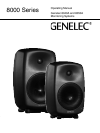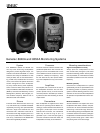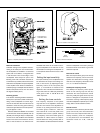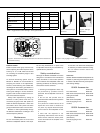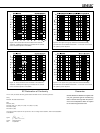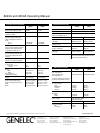
Minimum clearances
Sufficient cooling for the amplifier and func-
tioning of the reflex port must be ensured if
the loudspeaker is installed in a restricted
space such as a cabinet, or integrated into
a wall structure. The surroundings of the
loudspeaker must always be open to the
listening room with a minimum clearance of
5 centimeters (2") behind, above and on both
sides of the loudspeaker. The space adjacent
to the amplifier must either be ventilated or
sufficiently large to dissipate heat so that the
ambient temperature does not rise above
35 degrees Celsius (95°F).
Mounting options
The vibration insulating Isolation Positioner/
Decoupler™ (Iso-Pod™) table stand allows
tilting of the loudspeaker for correct align-
ment of the acoustic axis. The stand can be
attached to three mounting points allowing
vertical and symmetrical horizontal position-
ing (see figures 1 and 4).
Genelec 8040A and 8050A can be fitted
to Omnimount
®
Series 30 (8040A) and 60
(8050A) and König & Meyer loudspeaker
mounts on two sets of M6x10 mm threaded
holes on the back of the enclosure. On the
base of the enclosure is an M10x10 mm
threaded hole which can be used for secur-
ing the loudspeaker to its base. Do not use
this thread for mounting the loudspeaker on
a microphone stand which has a 3/8" UNC
thread.
Setting the input sensitivity
The input sensitivity of the loudspeakers can
be matched to the output of the mixing con-
sole, or other source, by adjusting the input
sensitivity control on the rear panel (see
figure 1). A screwdriver is needed for the
adjustment. The manufacturer’s default set-
ting for this control is -6 dBu (fully clockwise)
which gives an SPL of 100 dB @1m with
-6 dBu input level.
Setting the tone controls
The frequency response of the system
may also have to be adjusted to match the
acoustic environment. The adjustment is
carried out by setting the three tone con-
trol switch groups "treble tilt", "bass tilt"
and "bass roll-off" on the rear panel of the
amplifier. There is also a special "desktop
low frequency" tone control which gives an
attenuation of 4 dB at 160 Hz to compen-
sate the effect of a mixing console, desk or
other reflective surface between the listener
and the loudspeaker. The factory settings
for these controls are all "OFF" to give a flat
anechoic response.
Bass roll-off control
Bass roll-off (first switch group from the left)
affects the low frequency roll-off of the loud-
speaker and attenuates its energy output
near the cut-off frequency. Attenuation levels
of -2, -4 or -6 dB can be selected.
Desktop low frequency control
The desktop low frequency control (fourth
switch of first switch group from the left)
attenuates the bass frequencies around
160 Hz by 4 dB (see figures 8 and 10). This
feature is designed to compensate for the
boost often occurring at this frequency range
when the loudspeaker is placed upon a meter
bridge, table or similar reflective surface.
Bass tilt control
The bass tilt control switches (second switch
group from the left) offer three attenuation
levels for the bass response below 800 Hz,
usually necessary when the loudspeak-
ers are placed near room boundaries. The
attenuation levels are -2 dB, -4 dB and
-6 dB.
Figure 1. Amplifier panel layout of the 8040A
Figure 2. Location of the acoustic axis
Figure 3. RCA to XLR cable
Cable
Screen
RCA
(Source)
XLR
(Speaker)



